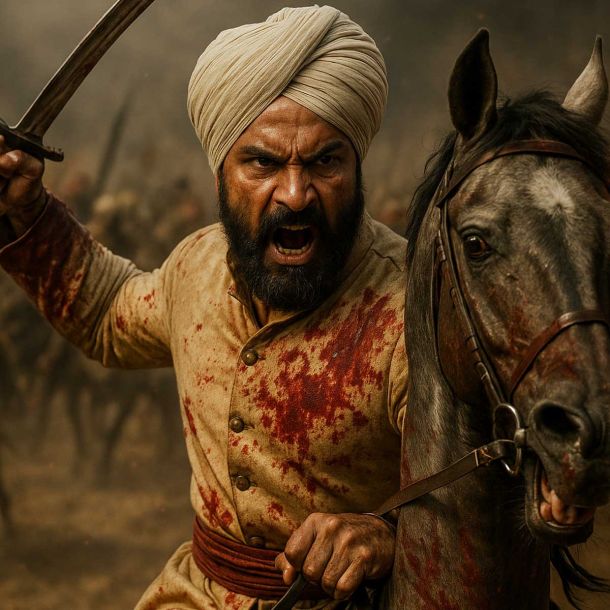Sanatan Articles
Satyaagrah
Written on
Satyaagrah
Written on
Satyaagrah
Written on
Satyaagrah
Written on
Satyaagrah
Written on
JOIN SATYAAGRAH SOCIAL MEDIA
“It’s like chess, you know. The Queen saves the King”: Yashovati - first regent queen of Kashmir married to King Damodara I who was kiIIed in a duel with Shri Krishna himself, Yashomati was pregnant than and was raised to the throne by Shri Krishna

Throughout ancient India, women were esteemed, and their contributions to the welfare of Throughout ancient India, women were esteemed, and their contributions to the welfare of the family and the community were vital. The elevated social standing of the ladies helped them feel good about themselves and gave them a sense of purpose. In order to develop their intellectual and spiritual capacities, they were provided with the chance. During this period, there were several female rishis.
|
Epic and Purana stories depicted women as largely linked to property. Since its beginning, Kashmir has been home to many great poets and other luminaries who have left behind a rich cultural legacy. Its monarchs restored its natural splendour by erecting world-famous landmarks and beautiful gardens, which are now frequented bythrongs of tourists. It's also worth pointing out that Kashmir has generated literature that will be preserved for a long time and pass on its wisdom to succeeding generations. It's also full be preserved for a long time and pass on its wisdom to succeeding generations. It's also fullof myths and legends dating all the way back to time immemorial.
History narrates the proven valour, gallantry, vigour and steadfastness of many Indian women who have distinguished themselves as powerful rulers, as regents of princes, commanders of militias, frugal landlords, diplomats in peace and war, and stood side by side with the menfolk with pride and glory.
Female rule in ancient Kashmir was also an acceptable cultural component, as revealed Female rule in ancient Kashmir was also an acceptable cultural component, as revealed by the Source of ancient Kashmir. Regardless of whether they were royalty or not, the women in charge of the affairs of the kingdom had legal authority. They laid the groundworkfor a more active role for women in a male-dominated society after their rule in the patriarchal system. “Yasovati of the Gonda dynasty, Sugandha (904-906 AD) of the Utpala dynasty, and Didda (980-1003 AD) of the Lohara dynasty were all queens of Kashmir.” Kota Rani, the last queen of Kashmir, was the fourth and final ruler. After her, the Kashmir crownpassed to Muslims, as she was the last Hindu ruler in the valley.
There is sufficient information in Kalhana’s Rajatarangini about the most laudable women of Kashmir, viz. Sugandha Devi, Rani Didda, Ishan Devi, Vakpushta, and one another name being that of Rani Yashovati, probably the first woman leader of the world who achieved an enviable position that enabled her to exercise enormous influence to the extent that, at times, even her foes had to bow to her decree. She ascended the throne at a time of great turmoil in Kashmir.
In the words of Dr. Sengupta: “Kashmir has been very much in the news since 1947 as if it is just a piece of terrain, over the possession of which warring forces are at bay .... We want the world to know a bit of the bubbling fountain of life that has been flowing through her arteries, since the Aryan immigrants settled first in this snow-capped valley, which constitutes a diadem of diamond on the head of India.”
|
India has thus a spiritual and an emotional connect to Kashmir. The relationship between Kashmir and the rest of the nation is the culmination of thousands of years of a deep living association.
Kalhana's Rajatarangini begins just before the great Mahabharata war, and the first King mentioned therein is Gonanda I, whose initial year of reign is placed in 653 Kali era, the traditional date of the coronation of King Yudhishthira, the eldest brother of the Pandavas. Gonanda I was a very powerful king who ruled Kashmir just about 20 years before the Mahabharata war. Historians identify the period of the rule of Gonanda I as taking place in 3238-3188 BCE; Damodara, in 3188-3140 BCE and Yashovati, after 3140 BCE.
King Gonanda was a powerful monarch with a big army whose amity was fondly desired by other rulers, one of them being King Jarasandh of Mathura. Jarasandh approached King Gonanda for help while fighting Shri Krishna’s army at Mathura. Gonanda’s army laid siege to Mathura and fought staunchly, but was killed by Balabhadra, the brother of Krishna. When the vanquished troops returned and reported the tragic death of the king, Gonanda’s son, Damodara, was crowned king.
The new ruler, however, felt aggrieved at the death of his father, and right from the day of his coronation, he constantly thought of avenging his father’s death. To quote Rajatarangini: “Although he obtained the kingdom furnished in plenitude with life’s enjoyment, the proud king brooding over the death of his father had not yet been at peace.”
Impelled by the desire for revenge, King Damodara attacked Krishna at the swayamvara which was held by the King of Gandhara. But Damodara’s action was ill-fated and he was slaughtered. Damodara was young and did not have a child at the time. Hence his wife, Yashovati, who was then enceinte, was made the queen of Kashmir. The demise of the two successive emperors and the demolition of vast battalions of armed forces had nearly thrown the government in a state of disorder. Nevertheless, the prudent, resolute empress brought back the land known to “be furnished in plenitude with life’s enjoyments’ to a state of normalcy and restored its strength.
After the death of Damodara, the ruling elite was timid enough to surrender to the victorious Sri Krishna. They were shocked to hear Sri Krishna’s command that Yashovati would occupy the throne. To make her rule acceptable to the subjects, Krishna adopted an unusual procedure by reciting this verse from the Nilmata Purana: ‘Kashmir land is Parvati; know that its king is a portion of Shiva. Though he be wicked, a wise man who desires his own prosperity will not despise him’. Kalhana confirms that Krishna appeased the advisers by reciting the above verse.
Although Yashovati was pregnant at the time (she was carrying the child of the deceased king in her womb), she ruled the kingdom with a stern hand, identifying the corrupt and unjust officials and punishing them severely. She thus ensured prompt delivery of justice to her subjects. She also exposed those members of the council who were plotting to overthrow her.
In due course, Yashovati gave birth to the male heir to the kingdom. History informs us that Sri Krishna named the child ‘Gonanda’ too. However, the council of ministers, in league with the royal priest, hatched a conspiracy to enthrone the infant in order to force the queen to abdicate the throne. But they failed miserably in their designs. Being brave, wise and a master strategist, Yashovati understood the game plan of the conspirators and inflicted a crushing blow on them. Eventually, she became the first woman ruler of Kashmir.
Yashovati was acutely aware of her duties and discharged them with elan and a high sense of responsibility. Efficiently running the administration, she carved a niche for herself and created a highly regarded position for herself among her subjects who viewed her as an embodiment of Shiva. She became very popular among the people, whose hearts she had won through her benign rule.
|
Rani Yashovati rule
Rani Yashovati is a unique symbol of women’s empowerment. She effectively shut down the criticism of those who scoff at womankind and believe that they can live only under the tutelage of men. Kalhana comments that several nobles and ambassadors who were full of vice would murmur that a woman must not be crowned but Krishna hushed them. Subsequently she was viewed as someone who was sacred and inviolable.
To quote Kalhana: “The eyes of men that viewed womankind with scanty courtesy, regarding them as objects of pleasure, looked upon this mother of her subjects as if she were their goddess.”
A detailed description of Yashovati’s reign is not available. It is not known how long the queen ruled over Kashmir i.e., how long as a regent and how long as a queen, even as her de facto rule over the valley is confirmed. Even the exact date of her accession to the throne has not been recorded by any historian, so much so that even Stein neglected to mention her while describing the chronology of the kings of Kashmir. The height of the negligence of this queen is clearly reflected in the way Kalhana treated her in his Rajatarangini, wherein he devoted just five verses to her. He neither mentioned the time period of her rule, nor did he mention for what length of time she remained the regent to her son Gonanda II.
But her role in the history of Kashmir, especially in helping the women to live a good standard of life cannot be denied. After her, society’s resistance to a woman’s rule almost vanished as can be clearly seen in the emergence of women rulers like Queen Sugandha, Didda and Kota Rani. Yashovati became the forerunner of other queens of Kashmir. Her reign, though short, made the path of women rulership easier and more acceptable.
After Kalhana, it was Prem Nath Bazaz who made mention of the queen, while a majority of the scholars neglected her role in legitimising women rule in Kashmir. Writes Bazaz, “Whether as the sovereign queen ruling in her own right or as a regent administering the country on behalf of her son, Yashovati proved a successful and popular ruler who fully understood her duties and efficiently discharged the responsibilities entrusted to her care.” (Bazaz 1959 p, 23). The queen ruler justified women’s rule and challenged the tradition of naming only a male as a successor to the throne.
Yashovati did not ignore her duty as a single parent and as a mother. She gave proper education to her son, befitting a prince. She raised him to become a brave, just and kind ruler. Eventually he came to be known as Gonanda II, who succeeded his mother and continued to rule on the guidelines laid down by his illustrious mother. Though history may not have been kind to her, as it has not been to so many of our social and cultural icons; nevertheless, it is time that we at least remember her for all that she did for Kashmir and India as a whole.
References:
 Support Us
Support Us
Satyagraha was born from the heart of our land, with an undying aim to unveil the true essence of Bharat. It seeks to illuminate the hidden tales of our valiant freedom fighters and the rich chronicles that haven't yet sung their complete melody in the mainstream.
While platforms like NDTV and 'The Wire' effortlessly garner funds under the banner of safeguarding democracy, we at Satyagraha walk a different path. Our strength and resonance come from you. In this journey to weave a stronger Bharat, every little contribution amplifies our voice. Let's come together, contribute as you can, and champion the true spirit of our nation.
 |  |  |
| ICICI Bank of Satyaagrah | Razorpay Bank of Satyaagrah | PayPal Bank of Satyaagrah - For International Payments |
If all above doesn't work, then try the LINK below:
Please share the article on other platforms
DISCLAIMER: The author is solely responsible for the views expressed in this article. The author carries the responsibility for citing and/or licensing of images utilized within the text. The website also frequently uses non-commercial images for representational purposes only in line with the article. We are not responsible for the authenticity of such images. If some images have a copyright issue, we request the person/entity to contact us at satyaagrahindia@gmail.com and we will take the necessary actions to resolve the issue.
Related Articles
- Nehru's Himalayan Blunders which costed India dearly - Pre-Independence
- Lalitadiya Muktapida: A great successor of Karkota Dynasty who defeated Arabs and subjugated Turks
- Hitler’s propaganda minister Joseph Goebbels said 'Repeat a lie often enough and it becomes the truth' - Whitewashing a genocide – how the exodus of Kashmiri Pandits is being blamed on Hindus instead of on Islamists
- In 1921, British forces brutally killed over 750 unarmed farmers in Munshiganj during a peaceful protest with experts calling it deadlier than Jallianwala Bagh while a memorial today stands as a grim reminder of their sacrifice & the atrocities committed
- Birsa Munda: The tribal folk hero who was God to his people by the age of 25
- The Balliol college at the University of Oxford has dedicated a new building after Dr. Lakshman Sarup, the first candidate at Oxford to pass his thesis for a Doctorate of Philosophy (DPhil) degree on Sanskrit treatise on etymology
- How Communism murdered Freedom of Expression: 100 Years of Russian Revolution
- 21-yr-old girl Bina Das shot Bengal Governor in her convocation programme at Calcutta University, got Padma Shri but died in penury
- 'Muh me ram bagal me chhuri' - Gandhi’s politics is hollow and noisy, full of treachery and deceit’: Read what Dr. Ambedkar said about the ‘Mahatma’
- To be on the wrong side of history is a choice – How 21st-century invaders are capturing Chhatrapati Shivaji’s forts the way even Mughals didn’t and attempting to reclaim an invader identity unapologetically
- "ओ मेरे मसरूफ़ ख़ुदा, अपनी दुनिया देख ज़रा": Grumpy and visibly irritated PDP leader Mehbooba Mufti blasted, “Supreme Court Not God. Its decision on Article 370 not God’s verdict", vows to continue to struggle for its restoration of special status to J&K
- Moplah Genocide of the Malabar Hindus, 1921: Thousands of Hindus slaughtered
- Natwar Singh, an ex-foreign minister, and the Congress Party through a series of illegal oil transactions under Saddam Hussein’s regime’s oil-for-food program were involved in the Iraqi oil scam: Detail in the Volcker Committee Report
- "In loyalty's absence, betrayal finds its stage": Indians sacrificed their life earnings to Netaji for a dream called freedom, Nehru, however, fancied a different richness: gifting it to Pakistan, Legacy decisions, they call it was one more great betrayal
- During Partition Hindu and Sikh refugees concentrated in Delhi to a humiliating and dehumanizing experience whereas Muslim were being provided with rations, funds, jobs and shelter: MK Pahwa try to assassinate Gandhi





















